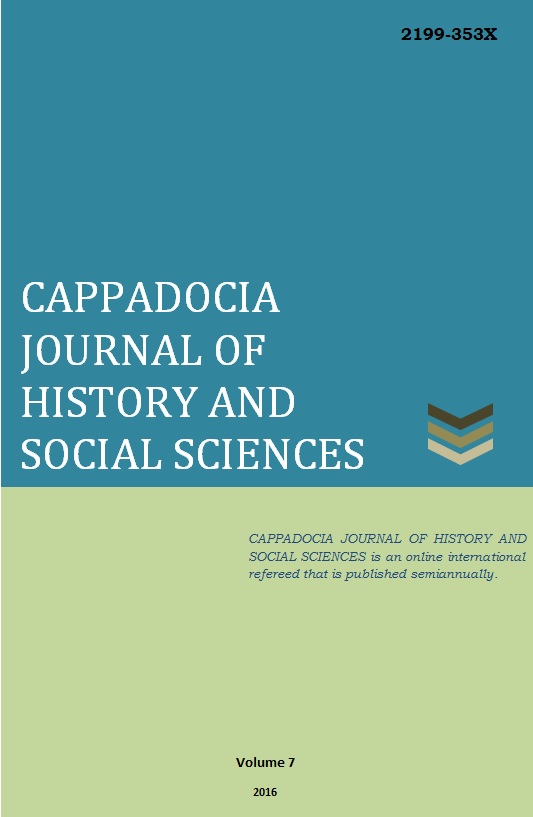Author :
Abstract
Bu çalışmada, Orta Anadolu’nun önemli tarihi ve turistik merkezlerinden biri olan Nevşehir’in Ürgüp ilçesinde bulunan bir cami incelenmiştir. Bölgenin önemli ailelerinin ikamet ettiği Kayakapı Mahallesi’nde inşa edilen caminin kitabesinin bulunmayışı bani, mimar ve inşa tarihi gibi bilgilerinin tespit edilmesini engellemektedir. Başbakanlık Osmanlı Arşivleri’nde tespit ettiğimiz belgeler neticesinde yapının bani ve inşa tarihine dair önemli sonuçlara ulaşılmıştır. Camideki süsleme kompozisyonları ile belgede tespit edilen tarihin süsleme anlayışının paralellik sergilediği görülmüştür. Yapı üzerindeki incelemelerde, tarihi süreç içerisinde caminin çeşitli değişikler geçirdiği de anlaşılmıştır. Netice olarak elde edilen bilgi, belge ve bulgular doğrultusunda caminin 1734 yılından kısa bir süre önce, bölgenin önemli hayırseverlerinden Davud Ağa tarafından inşa ettirildiği tespit edilmiştir. 19. yüzyıl ile 20. yüzyıl başlarında ise yöre geleneğinin de etkisiyle camiye bir de yazlık bölümün ilave edildiği sonucuna varılmıştır.
Keywords
Abstract
In this study, a mosque in the town of Ürgüp, an important historic and touristic center in the province of Nevşehir in Central Anatolia, has been researched. Due to the lack of an inscription with the mosque, housed in Kayakapı district once inhabited by the prominent families of the area, to establish the donor, architect or the construction date has not been possible. However, some important information about the donor and the construction date of the building has been reached through the documents found in the Ottoman Archive of the Prime Ministry. It has been observed that the compositions of decoration in the mosque and the perception of decoration of the period, pointed by this document, resemble. As a result of the researches carried out on the building, it has also been inferred that the building has gone through some changes in the past. As a result, in the light of information, documents and findings obtained during this study, it has been confirmed that Davud Ağa, one of the significant benefactors in the area, had the mosque built shortly before 1734. It has also concluded that a summer section was added in the 19th century or the beginning of the 20th with the influence of the local tradition.
Keywords
- AKAR, Azade, “Tezyini San’atlarımızda Vazo Motifleri”, Vakıflar Dergisi, Sayı: 8, Ankara, 1969, s. 267– 271.
- AKTUĞ, İlknur, Nevşehir Damat İbrahim Paşa Külliyesi, Ankara, 1992.
- ALTIN, Alper, Kayseri Minberleri (Cumhuriyet Dönemine Kadar), (Erciyes Üniversitesi, Sosyal Bilimler Enstitüsü, Basılmamış Yüksek Lisans Tezi), Kayseri, 2011.
- ATAK, Erkan, Anadolu’da Lale Devri Mimarisi (İstanbul Dışı Örnekler Üzerine Bir Araştırma),(Çanakkale Onsekiz Mart Üniversitesi, Sosyal Bilimler Enstitüsü, Basılmamış Doktora Tezi), Çanakkale, 2014.
- AYDIN, Remzi, Kayseri Mihrabları, (Selçuk Üniversitesi, Sosyal Bilimler Enstitüsü, Basılmamış Yüksek Lisans Tezi), Konya, 2006.
- BARIŞTA, H. Örcün, İstanbul Çeşmeleri Bereketzade Çeşmesi, İstanbul, 1989.
- BARIŞTA, H. Örcün, İstanbul Çeşmeleri Beyoğlu Cihetinden Meyva Tabağı Motifleriyle Bezenmiş Tek Cepheli Anıt Çeşmeler, Ankara, 1991.
- BARIŞTA, H. Örcün, Azapkapı Saliha Sultan Çeşmesi, Ankara, 1995.
- CANCA, Gülçin Erol, “Üsküdar Ahmediye Külliyesi Ve Lale Devri Mimarisi İçinde Bir Değerlendirme”, Üsküdar Sempozyumu VI, Cilt: 1, İstanbul, 2009, s. 191–202.
- ERAVŞAR, Osman, Ürgüp ve Çevresindeki Türk-İslâm Devri Yapıları, (Selçuk Üniversitesi, Sosyal Bilimler Enstitüsü, Basılmamış Yüksek Lisans Tezi), Konya, 1993.
- GÜRLEK, Nazife, “Davud Ağa Konağı”, Kayakapı Bülteni, Sayı: 8, Ürgüp, 2014, s. 4–7.
- KOÇYİĞİT, Fazilet, Lale Devri İstanbul Çeşmeleri, (Erciyes Üniversitesi, Sosyal Bilimler Enstitüsü, Basılmamış Doktora Lisans Tezi), Kayseri, 2013.
- OFLAZ, Mustafa, “Ürgüp”, Türkiye Diyanet Vakfı İslam Ansiklopedisi, Cilt: 42, İstanbul, 2012, s. 359–ÖZBEK, Yıldıray-Celil, ARSLAN, Kayseri Taşınmaz Kültür Varlıkları Envanteri, Cilt: I, Kayseri, 2008.
- PINAR, Mehmet, Nevşehir Mihrapları, (Erciyes Üniversitesi, Sosyal Bilimler Enstitüsü, Basılmamış Yüksek Lisans Tezi), Kayseri, 2011.
- SEZGİN, Uğur, XVIII. Yüzyılda Nevşehir ve İlçelerindeki Osmanlı Dini Mimari Eserleri, , (Yüzüncü Yıl Üniversitesi, Sosyal Bilimler Enstitüsü, Basılmamış Yüksek Lisans Tezi), Van, 2002.
- SÖYLEMEZ, Duygu İlkhan, Batılılaşma Dönemi İstanbul Cami Cephelerinde Taş Süsleme (1703–1839), Selçuk Üniversitesi, Sosyal Bilimler Enstitüsü, Basılmamış Yüksek Lisans Tezi), Konya, 2010.
- TOPÇU, Sultan Murat, “Kayserili Mimar El-Hac Mehmet Ağa’nın Kayseri’deki Hayratı” Karadeniz, Sayı: 13, Ardahan, 2012, s. 47–62.
- ÜNVER, Gülbün, “Osmanlı Sanatında Vazolu ve Vazosuz Çiçek Demetleri” Vakıflar Dergisi, Sayı: 9, Ankara, 1971, s. 321–325.





